SUBARU OUTBACK 2005 4.G Owners Manual
Manufacturer: SUBARU, Model Year: 2005, Model line: OUTBACK, Model: SUBARU OUTBACK 2005 4.GPages: 627, PDF Size: 6.42 MB
Page 431 of 627
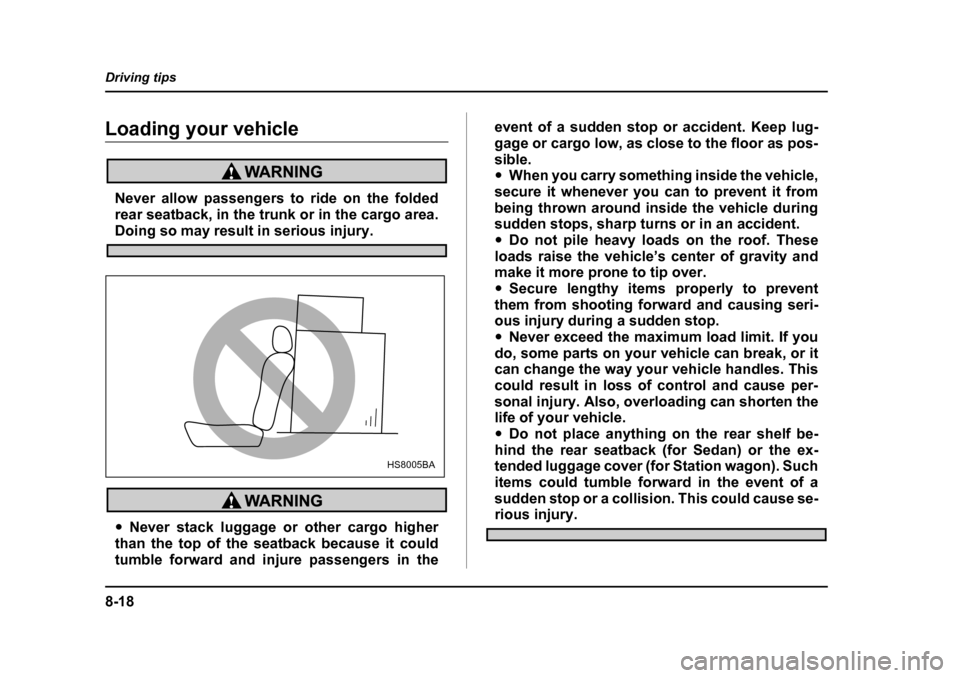
8-18
Driving tips
Loading your vehicle
Never allow passengers to ride on the folded
rear seatback, in the trunk or in the cargo area.
Doing so may result in serious injury.
"
Never stack luggage or other cargo higher
than the top of the seatback because it could
tumble forward and injure passengers in the event of a sudden stop or accident. Keep lug-
gage or cargo low, as close to the floor as pos-
sible. "
When you carry something inside the vehicle,
secure it whenever you can to prevent it from
being thrown around inside the vehicle during
sudden stops, sharp turns or in an accident. " Do not pile heavy loads on the roof. These
loads raise the vehicle’s center of gravity and
make it more prone to tip over. " Secure lengthy items properly to prevent
them from shooting forward and causing seri-
ous injury during a sudden stop. " Never exceed the maximum load limit. If you
do, some parts on your vehicle can break, or it
can change the way your vehicle handles. This
could result in loss of control and cause per-
sonal injury. Also, overloading can shorten the
life of your vehicle. " Do not place anything on the rear shelf be-
hind the rear seatback (for Sedan) or the ex-
tended luggage cover (for Station wagon). Such
items could tumble forward in the event of a
sudden stop or a collision. This could cause se-rious injury.
HS8005BA
Page 432 of 627
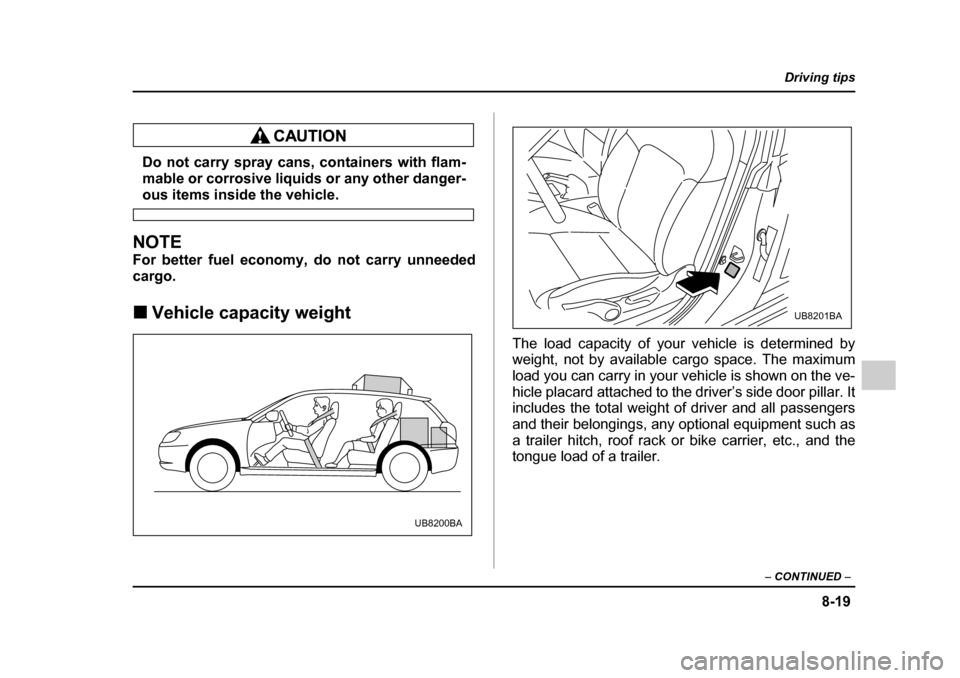
8-19
Driving tips
– CONTINUED –
Do not carry spray cans, containers with flam-
mable or corrosive liquids or any other danger-
ous items inside the vehicle.
NOTE
For better fuel economy, do not carry unneeded
cargo. !Vehicle capacity weight
The load capacity of your vehicle is determined by
weight, not by available cargo space. The maximum
load you can carry in your vehicle is shown on the ve-
hicle placard attached to the driver’s side door pillar. It
includes the total weight of driver and all passengers
and their belongings, any optional equipment such as
a trailer hitch, roof rack or bike carrier, etc., and the
tongue load of a trailer.
UB8200BA
UB8201BA
Page 433 of 627
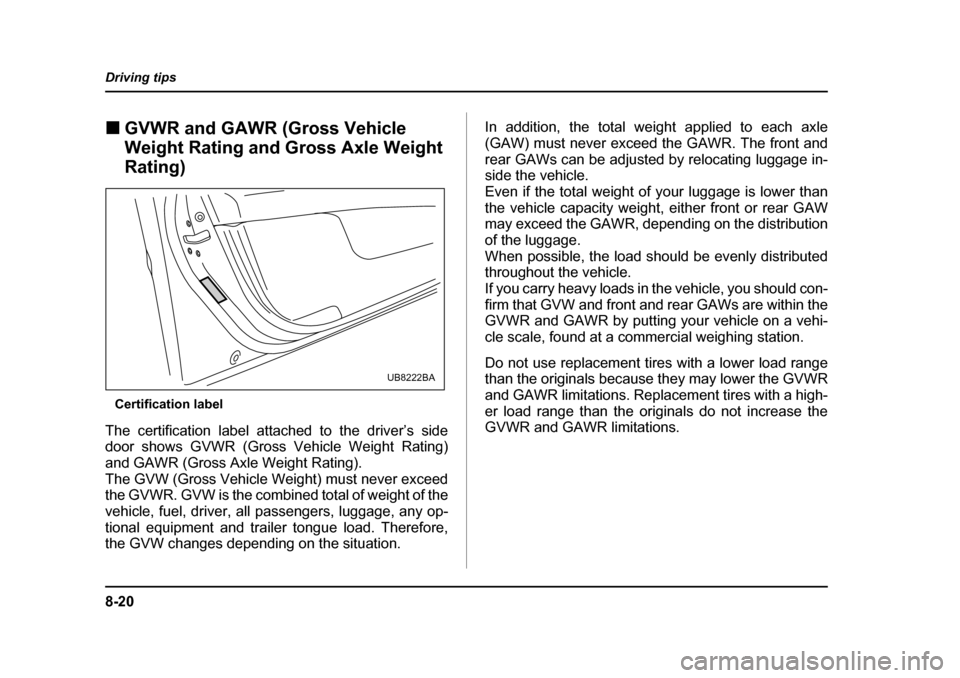
8-20
Driving tips
!
GVWR and GAWR (Gross Vehicle
Weight Rating and Gross Axle Weight Rating)
Certification label
The certification label attached to the driver’s side
door shows GVWR (Gross Vehicle Weight Rating)
and GAWR (Gross Axle Weight Rating).
The GVW (Gross Vehicle Weight) must never exceed
the GVWR. GVW is the combined total of weight of the
vehicle, fuel, driver, all passengers, luggage, any op-
tional equipment and trailer tongue load. Therefore,
the GVW changes depending on the situation. In addition, the total weight applied to each axle
(GAW) must never exceed the GAWR. The front and
rear GAWs can be adjusted by relocating luggage in-
side the vehicle.
Even if the total weight of your luggage is lower than
the vehicle capacity weight, either front or rear GAW
may exceed the GAWR, depending on the distribution
of the luggage.
When possible, the load should be evenly distributed
throughout the vehicle.
If you carry heavy loads in the vehicle, you should con-
firm that GVW and front and rear GAWs are within the
GVWR and GAWR by putting your vehicle on a vehi-
cle scale, found at a commercial weighing station.
Do not use replacement tires with a lower load range
than the originals because they may lower the GVWR
and GAWR limitations. Replacement tires with a high-
er load range than the originals do not increase the
GVWR and GAWR limitations.
UB8222BA
Page 434 of 627
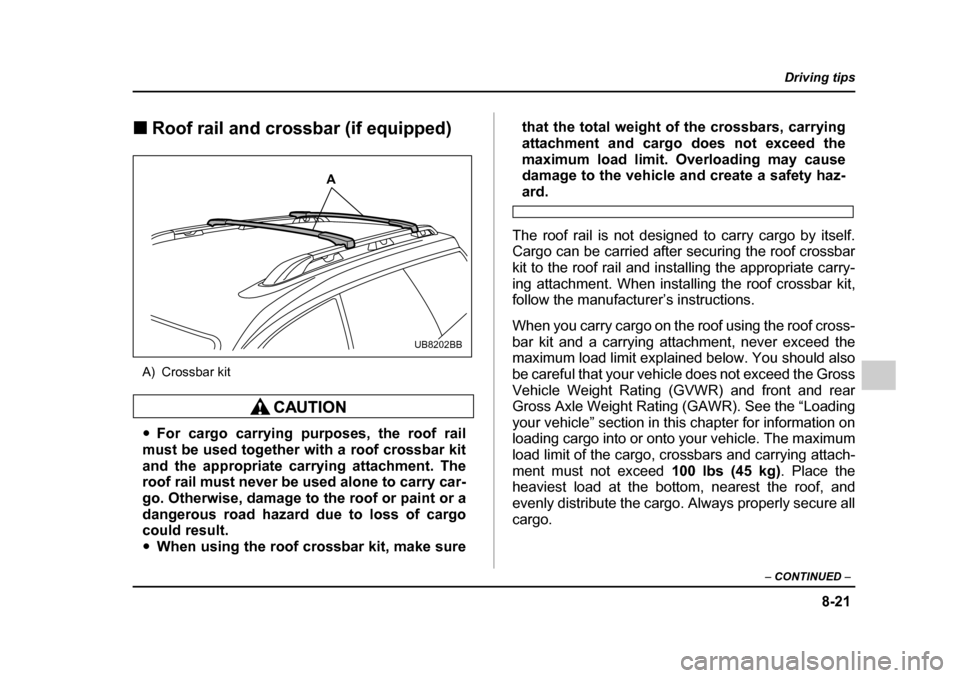
8-21
Driving tips
– CONTINUED –
!Roof rail and crossbar (if equipped)
A) Crossbar kit
" For cargo carrying purposes, the roof rail
must be used together with a roof crossbar kit
and the appropriate carrying attachment. The
roof rail must never be used alone to carry car-
go. Otherwise, damage to the roof or paint or a
dangerous road hazard due to loss of cargo
could result. " When using the roof crossbar kit, make sure that the total weight of the crossbars, carrying
attachment and cargo does not exceed the
maximum load limit. Overloading may cause
damage to the vehicle and create a safety haz-
ard.
The roof rail is not designed to carry cargo by itself.
Cargo can be carried after securing the roof crossbar
kit to the roof rail and installing the appropriate carry-
ing attachment. When installing the roof crossbar kit,
follow the manufacturer’s instructions.
When you carry cargo on the roof using the roof cross-
bar kit and a carrying attachment, never exceed the
maximum load limit explained below. You should also
be careful that your vehicle does not exceed the Gross
Vehicle Weight Rating (GVWR) and front and rear
Gross Axle Weight Rating (GAWR). See the “Loading
your vehicle” section in this chapter for information on
loading cargo into or onto your vehicle. The maximum
load limit of the cargo, crossbars and carrying attach-
ment must not exceed 100 lbs (45 kg). Place the
heaviest load at the bottom, nearest the roof, and
evenly distribute the cargo. Always properly secure all cargo.A
UB8202BB
Page 435 of 627
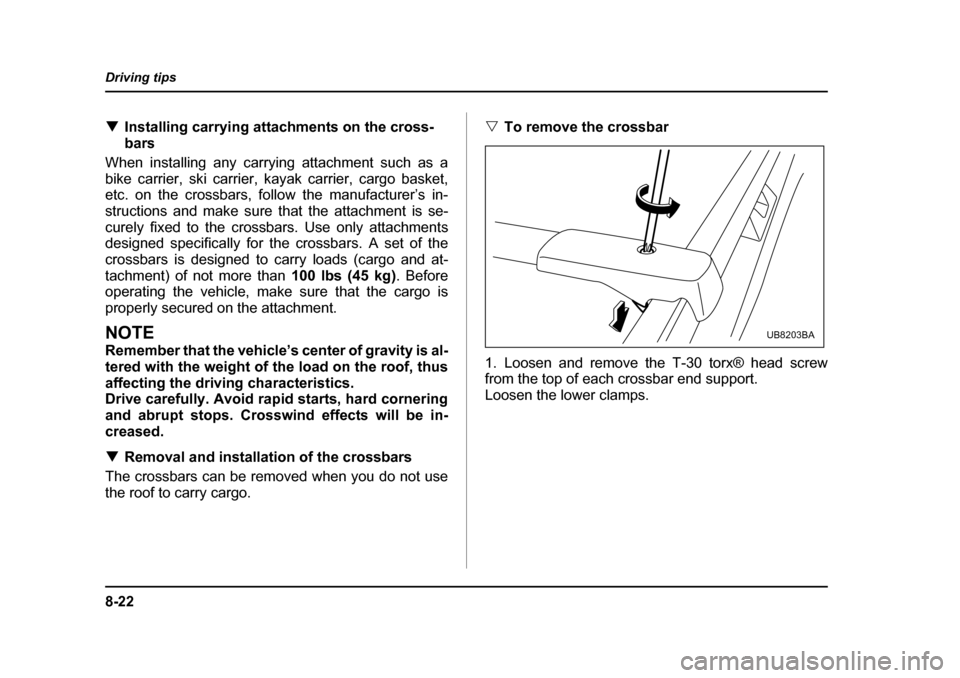
8-22
Driving tips
!
Installing carrying attachments on the cross-
bars
When installing any carrying attachment such as a
bike carrier, ski carrier, kayak carrier, cargo basket,
etc. on the crossbars, follow the manufacturer’s in-
structions and make sure that the attachment is se-
curely fixed to the crossbars. Use only attachments
designed specifically for the crossbars. A set of the
crossbars is designed to carry loads (cargo and at-tachment) of not more than 100 lbs (45 kg). Before
operating the vehicle, make sure that the cargo is
properly secured on the attachment.
NOTE
Remember that the vehicle’s center of gravity is al-
tered with the weight of the load on the roof, thus
affecting the driving characteristics.
Drive carefully. Avoid rapid starts, hard cornering
and abrupt stops. Crosswind effects will be in-
creased. ! Removal and installation of the crossbars
The crossbars can be removed when you do not use the roof to carry cargo. "
To remove the crossbar
1. Loosen and remove the T-30 torx® head screw
from the top of each crossbar end support.
Loosen the lower clamps.UB8203BA
Page 436 of 627
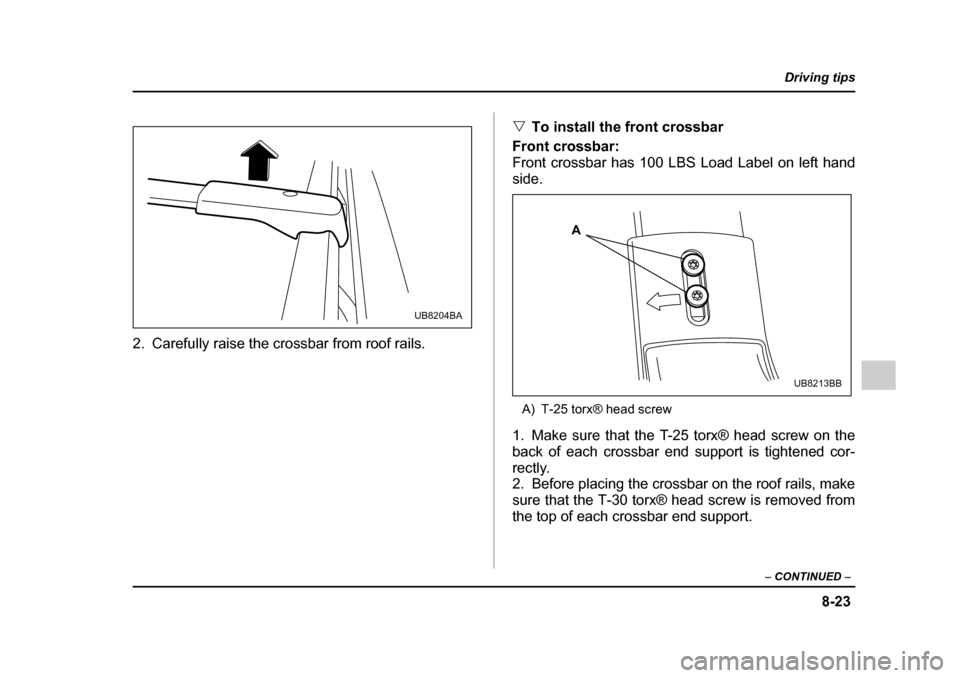
8-23
Driving tips
– CONTINUED –
2. Carefully raise the crossbar from roof rails. "
To install the front crossbar
Front crossbar:
Front crossbar has 100 LBS Load Label on left handside.
A) T-25 torx® head screw
1. Make sure that the T-25 torx® head screw on the
back of each crossbar end support is tightened cor-
rectly.
2. Before placing the crossbar on the roof rails, make
sure that the T-30 torx® head screw is removed from
the top of each crossbar end support.
UB8204BA
A
UB8213BB
Page 437 of 627
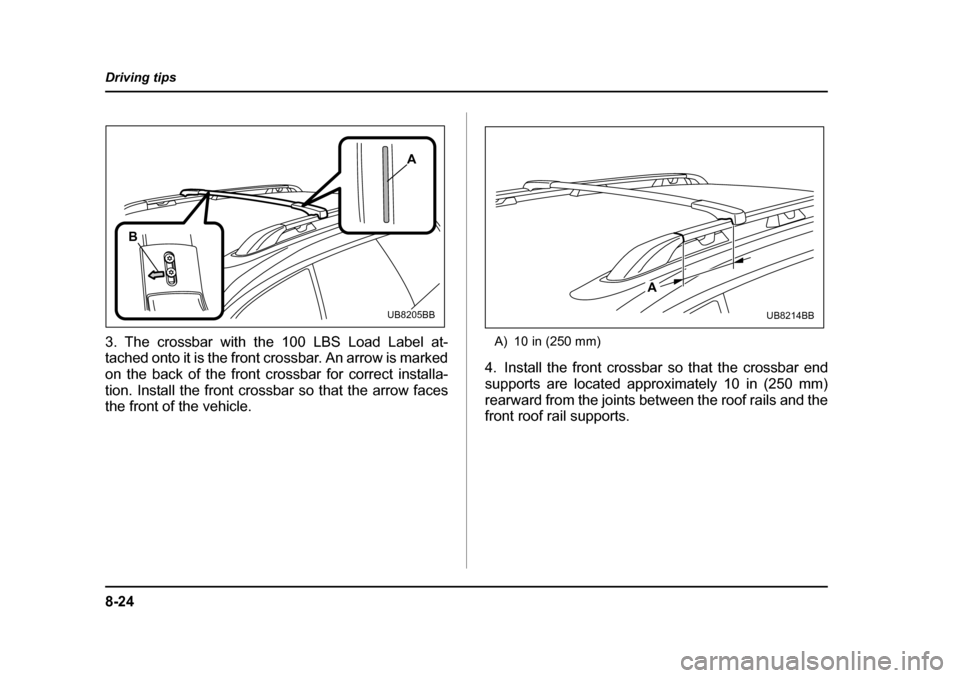
8-24
Driving tips
3. The crossbar with the 100 LBS Load Label at-
tached onto it is the front crossbar. An arrow is marked
on the back of the front crossbar for correct installa-
tion. Install the front crossbar so that the arrow faces
the front of the vehicle.
A) 10 in (250 mm)
4. Install the front crossbar so that the crossbar end
supports are located approximately 10 in (250 mm)
rearward from the joints between the roof rails and the
front roof rail supports.
B A
UB8205BB
A
UB8214BB
Page 438 of 627
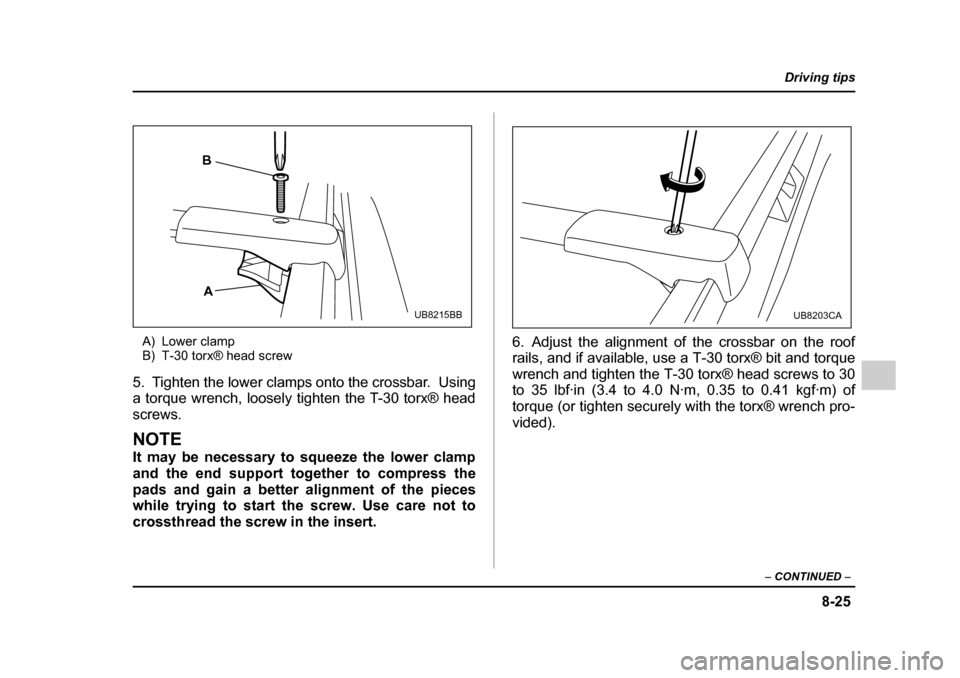
8-25
Driving tips
– CONTINUED –
A) Lower clamp
B) T-30 torx® head screw
5. Tighten the lower clamps onto the crossbar. Using
a torque wrench, loosely tighten the T-30 torx® head
screws.
NOTE
It may be necessary to squeeze the lower clamp
and the end support together to compress the
pads and gain a better alignment of the pieces
while trying to start the screw. Use care not to
crossthread the screw in the insert. 6. Adjust the alignment of the crossbar on the roof
rails, and if available, use a T-30 torx® bit and torque
wrench and tighten the T-30 torx® head screws to 30
to 35 lbf·in (3.4 to 4.0 N·m, 0.35 to 0.41 kgf·m) of
torque (or tighten securely with the torx® wrench pro-
vided).
A
B
UB8215BBUB8203CA
Page 439 of 627
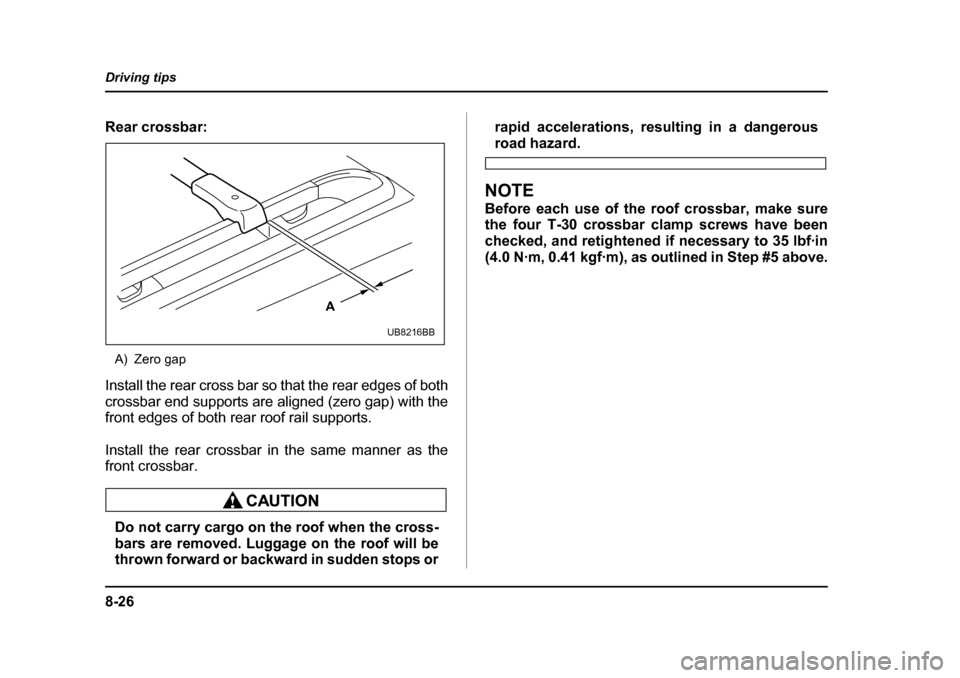
8-26
Driving tips
Rear crossbar:
A) Zero gap
Install the rear cross bar so that the rear edges of both
crossbar end supports are aligned (zero gap) with the
front edges of both rear roof rail supports.
Install the rear crossbar in the same manner as the
front crossbar.
Do not carry cargo on the roof when the cross-
bars are removed. Luggage on the roof will be
thrown forward or backward in sudden stops or rapid accelerations, resulting in a dangerous
road hazard.
NOTE
Before each use of the roof crossbar, make sure
the four T-30 crossbar clamp screws have been
checked, and retightened if necessary to 35 lbf·in
(4.0 N·m, 0.41 kgf·m), as outlined in Step #5 above.
A
UB8216BB
Page 440 of 627
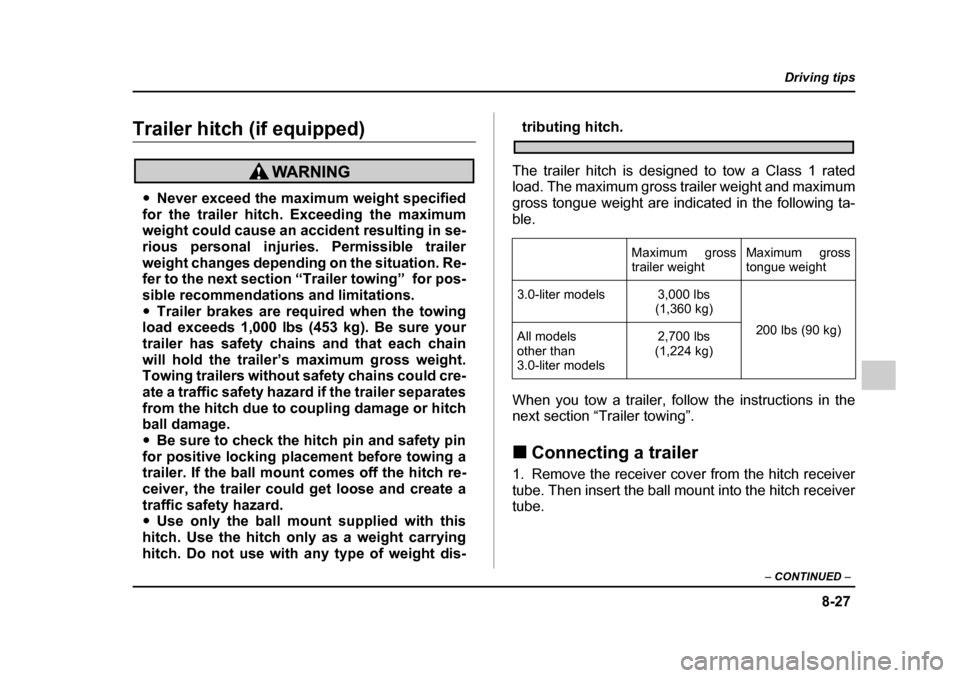
8-27
Driving tips
– CONTINUED –
Trailer hitch (if equipped)
"Never exceed the maximum weight specified
for the trailer hitch. Exceeding the maximum
weight could cause an accident resulting in se-
rious personal injuries. Permissible trailer
weight changes depending on the situation. Re-
fer to the next section “Trailer towing” for pos-
sible recommendations and limitations. " Trailer brakes are required when the towing
load exceeds 1,000 lbs (453 kg). Be sure your
trailer has safety chains and that each chain
will hold the trailer’s maximum gross weight.
Towing trailers without safety chains could cre-
ate a traffic safety hazard if the trailer separates
from the hitch due to coupling damage or hitch
ball damage. " Be sure to check the hitch pin and safety pin
for positive locking placement before towing a
trailer. If the ball mount comes off the hitch re-
ceiver, the trailer could get loose and create a
traffic safety hazard." Use only the ball mount supplied with this
hitch. Use the hitch only as a weight carrying
hitch. Do not use with any type of weight dis-
tributing hitch.
The trailer hitch is designed to tow a Class 1 rated
load. The maximum gross trailer weight and maximum
gross tongue weight are indicated in the following ta-
ble.
When you tow a trailer, follow the instructions in the
next section “Trailer towing”. ! Connecting a trailer
1. Remove the receiver cover from the hitch receiver
tube. Then insert the ball mount into the hitch receiver
tube. Maximum gross
trailer weight
Maximum gross
tongue weight
3.0-liter models 3,000 lbs (1,360 kg)
200 lbs (90 kg)
All models
other than
3.0-liter models 2,700 lbs
(1,224 kg)